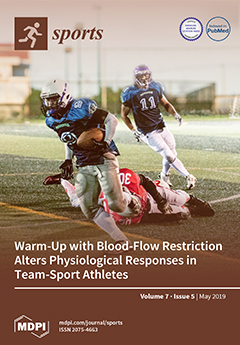Small-sided games (SSGs) are a recommended training method for significant performance enhancement, and training efficiency. The stop-ball (SSG-SB) effects on physical responses (e.g., acceleration, deceleration, sprints, total distance, and indicator of workload) have not been investigated yet. This study aimed to investigate the
[...] Read more.
Small-sided games (SSGs) are a recommended training method for significant performance enhancement, and training efficiency. The stop-ball (SSG-SB) effects on physical responses (e.g., acceleration, deceleration, sprints, total distance, and indicator of workload) have not been investigated yet. This study aimed to investigate the effects of the SSG-SB compared to the small-goals SSG (SSG-SG) on physical and heart rate (HR) responses at high intensity (total distance (>18 km/h)), sprints (>18 km/h), and acceleration and deceleration (>3 m/s²) during a 4 vs. 4 SSG format in youth professional soccer players. Sixteen male elite young soccer players (mean ± SD body height, 176.5 ± 6.3 cm; age, 18.3 ± 0.7 years; body weight, 73.4 ± 7.2 kg) performed two forms of SSGs, i.e., SSG-SB or SSG-SG, for 4 × 4 min with a recovery of 2 min between sets. Data were compared using the
t-test. The SSG-SB induced a significantly higher mean HR (180.0 ± 2.0 vs. 173.0 ± 3.0 beats per minute;
p < 0.05) compared to the SSG-SG. Likewise, the SSG-SB was significantly higher compared to the SSG-SG for total distance (2580 ± 220.3 vs. 2230 ± 210 m;
p < 0.001), player load (98.07 ± 12.5 vs. 89.4 ± 10.5;
p < 0.05), sprint distance (7.9 ± 2.3 vs. 5.2 ± 2.0 m;
p < 0.05), acceleration (15.6 ± 2.75 vs. 12.5 ± 1.75;
p < 0.05), and deceleration (17.3 ± 3.20 vs. 14.4 ± 2.55;
p < 0.05). However, no significant difference was found between the SSG-SG and the SSG-SB for maximal velocity, power, and sprints duration. This study provides new information about the effectiveness of the SSG-SB as a training stimulus for soccer.
Full article






